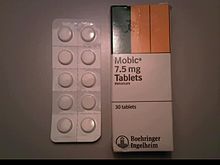- Meloxicam
-
Meloxicam 
Systematic (IUPAC) name 4-hydroxy-2-methyl-N-(5-methyl-2-thiazolyl)-2H-1,2-benzothiazine-3-carboxamide-1,1-dioxide. Clinical data Trade names Mobic AHFS/Drugs.com monograph MedlinePlus a601242 Pregnancy cat. C(US) D in third trimester Legal status POM (UK) ℞-only (US) Routes Oral Pharmacokinetic data Bioavailability 89% Protein binding 99.4% Metabolism Hepatic (CYP2C9 and 3A4-mediated) Half-life 15 to 20 hours Excretion Urine and faeces equally Identifiers CAS number 71125-38-7 
ATC code M01AC06 PubChem CID 5281106 DrugBank APRD00529 ChemSpider 10442740 
UNII VG2QF83CGL 
KEGG D00969 
ChEMBL CHEMBL599 
Chemical data Formula C14H13N3O4S2 Mol. mass 351.403 g/mol SMILES eMolecules & PubChem  (what is this?) (verify)
(what is this?) (verify)Meloxicam is a nonsteroidal anti-inflammatory drug (NSAID) with analgesic and fever reducer effects. It is a derivative of oxicam, closely related to piroxicam, and falls in the enolic acid group of NSAIDs.[1] It was developed by Boehringer-Ingelheim.
Contents
Mechanism of action
Main article: Non-steroidal anti-inflammatory drugMeloxicam inhibits cyclooxygenase (COX), the enzyme responsible for converting arachidonic acid into prostaglandin H2—the first step in the synthesis of prostaglandins, which are mediators of inflammation. Meloxicam has been shown, especially at its low therapeutic dose, selectively to inhibit COX-2 over COX-1.[2]
Meloxicam concentrations in synovial fluid range from 40% to 50% of those in plasma. The free fraction in synovial fluid is 2.5 times higher than in plasma, due to the lower albumin content in synovial fluid as compared to plasma. The significance of this penetration is unknown,[1] but it may account for the fact that it performs exceptionally well in treatment of arthritis in animal models.[3]
Adverse effects
Meloxicam use can result in gastrointestinal toxicity and bleeding, tinnitus, blinding headaches, rash, and very dark or black stool (a sign of intestinal bleeding). It has fewer gastrointestinal side effects than diclofenac,[4] piroxicam,[5] naproxen,[6] and perhaps all other NSAIDs which are not COX-2 selective.[4] Although meloxicam does inhibit thromboxane A, it does not appear to do so at levels that would interfere with platelet function.
Veterinary use
Meloxicam is also used in the veterinary field, most commonly in dogs, but also sees off-label use in other animals such as cattle, cats and exotics. [7][8] The U.S. Food and Drug Administration sent a Notice of Violation to the manufacturer for its promotional materials which included promotion of the drug for off-label use.[9] In the U.S. the drug is indicated for management of pain and inflammation associated with osteoarthritis in dogs only. In Europe, where the product has been available since the early 1990s, it is also prescribed and licensed for other anti-inflammatory benefits including relief from both acute and chronic pain in dogs. Side effects in animals are similar to those found in humans; the principal side effect is gastrointestinal irritation (vomiting, diarrhea and ulceration). Rarer but important side effects include liver and kidney toxicity.
Since 2003, the oral (liquid) formulations of meloxicam have been licensed in the U.S for use in dogs only,[10] with the January 2005 product insert specifically warning in bold-face type: "Do not use in cats."[11] An injectable formulation for use in dogs was approved by the FDA November 2003,[12] with a formulation for cats, for surgical use only, approved in October, 2004.[13]
In the U.S., per the manufacturer's clinical instructions as of July 2010, injectable meloxicam is indicated in operative use with felines as a single, one-time dose only, with specific and repeated warnings not to administer a second dose.[14] In June 2007, a new oral version of meloxicam was licensed in Europe for the long-term relief of pain in cats. As of June 2008, meloxicam is registered for long term use in cats in Australia, New Zealand, and throughout Europe.
Consumer confidence
As issues arise with any drug used off-label, the off-label use of meloxicam in cats has led to many reports of irreversible renal damage and death.[15] A peer-reviewed journal article cites feline overdose of NSAIDs, including meloxicam, as being a cause of severe kidney damage in cats.[16]
Brands
In Europe, meloxicam is marketed under the brand names Movalis, Melox, and Recoxa. In the UK, U.S., Middle East, Argentina, Paraguay, Uruguay and Australia it is marketed under the brand name Mobic, in Germany as Mobec, and in Canada as Mobicox. In Latin America, the drug is marketed as Tenaron, Ilacox, Mavicam, Melocam, or Artriflam. A veterinary formulation of the drug is marketed as Metacam, Meloxidyl, Meloxoral, Meloxidolor or Petcam. In the Philippines, it is generally marketed under the brand name Moxen. In Greece, it is manufactured under licence from aVianex S.A under the name Loxitan.[17]
References
- ^ a b "Meloxicam official FDA information, side effects, and uses". Drugs.com. March 2010. http://www.drugs.com/pro/meloxicam.html. Retrieved 17 March 2010.
- ^ Noble, S; Balfour, JA (Mar 1996). "Meloxicam". Drugs 51 (3): 424–30; discussion 431–32. doi:10.2165/00003495-199651030-00007. PMID 8882380.
- ^ Engelhardt, G; Homma, D; Schlegel, K; Utzmann, R; Schnitzler, C (Oct 1995). "Anti-inflammatory, analgesic, antipyretic and related properties of meloxicam, a new non-steroidal anti-inflammatory agent with favourable gastrointestinal tolerance". Inflammation Research 44 (10): 423–433. doi:10.1007/BF01757699. PMID 8564518.
- ^ a b Hawkey, C; Kahan, A; Steinbrü, K; Alegre, C; Baumelou, E; Bégaud, B; Dequeker, J; Isomäki, H et al. (Sept 1998). "Gastrointestinal tolerability of meloxicam compared to diclofenac in osteoarthritis patients". Rheumatology 37 (9): 937–45(9).
- ^ Dequeker, J; Hawkey, C; Kahan, A; Steinbruck, K; Alegre, C; Baumelou, E; Begaud, B; Isomaki, H et al. (1998). "Improvement in gastrointestinal tolerability of the selective cyclooxygenase (COX)-2 inhibitor, meloxicam, compared with piroxicam: results of the Safety and Efficacy Large-scale Evaluation of COX- inhibiting Therapies (SELECT) trial in osteoarthritis". The British Journal of Rheumatology 37 (9): 946–51. doi:10.1093/rheumatology/37.9.946. PMID 9783758.
- ^ Wojtulewski, JA; Schattenkirchner, M; Barceló, P; Le Loët, X; Bevis, PJR; Bluhmki, E; Distel, M. "A Six-Month Double-Blind Trial to Compare the Efficacy and Safety of Meloxicam 7.5 mg Daily and Naproxen 750 mg Daily in Patients with Rheumatoid Arthritis". Rheumatology 35, Supplement 1: 22–8.
- ^ Off-label use discussed in: Arnold Plotnick MS, DVM, ACVIM, ABVP, Pain Management using Metacam, and Stein, Robert, Perioperative Pain Managemment Part IV, Looking Beyond Butorphanol, Sep 2006.
- ^ For off-label use example in rabbits, see Krempels, Dana, Hind Limb Paresis and Paralysis in Rabbits, University of Miami Biology Department.
- ^ US FDA Notice of Violation for off-label use promotion, April 2005.
- ^ "NADA 141-213: New Animal Drug Application Approval (for Metacam® (meloxicam) 0.5 mg/mL and 1.5 mg/mL Oral Suspension)". US Food and Drug Administration. April 15, 2003. http://www.fda.gov/downloads/AnimalVeterinary/Products/ApprovedAnimalDrugProducts/FOIADrugSummaries/ucm118006.pdf. Retrieved 24 July 2010.
- ^ Metacam Client Information Sheet, product description: "Non-steroidal anti-inflammatory drug for oral use in dogs only", and in the "What Is Metacam" section in bold-face type: "Do not use in cats.", January 2005.
- ^ Metacam 5 mg/mL Solution for Injection
- ^ Metacam 5 mg/mL Solution for Injection, Supplemental Approval October 28, 2004.
- ^ See the manufacturer's FAQ on its website, and its clinical dosing instructions for cats.
- ^ Discussion of Metacam use at persiancats.org in Metacam Risks In Cats, and at the consumer site metacamkills.com.
- ^ Merola, Valentina, DVM, DABT, and Dunayer Eric, MS, VMD, DABT, The 10 most common toxicoses in cats, Toxicology Brief, Veterinary Medicine, pp. 340-342, June, 2006.
- ^ Εθνικό συνταγολόγιο, Greece's National subscription list, entry on Meloxicam entry on Meloxicam .
External links
Anti-inflammatory products (M01A) Pyrazolidine/Butylpyrazolidines Ampyrone • Clofezone • Kebuzone • Metamizole • Mofebutazone • Oxyphenbutazone • Phenazone • Phenylbutazone • Sulfinpyrazone • Feprazone •Acetic acid derivatives
and related substancesAceclofenac • Acemetacin • Alclofenac • Bromfenac • Bumadizone • Bufexamac • Diclofenac • Difenpiramide • Etodolac • Fentiazac • Indometacin • Ketorolac • Lonazolac • Oxametacin • Proglumetacin • Sulindac • Tolmetin • Zomepirac • AmfenacOxicams Propionic acid derivatives Alminoprofen • Benoxaprofen • Dexibuprofen • Dexketoprofen • Fenbufen • Fenoprofen • Flunoxaprofen • Flurbiprofen • Ibuprofen • Ibuproxam • Indoprofen • Ketoprofen • Naproxen • Oxaprozin • Pirprofen • Suprofen • Tiaprofenic acidFenamates Coxibs Other Categories:- Dog health
- Cat health
- Non-steroidal anti-inflammatory drugs
- Thiazoles
- Veterinary drugs
- Amides
- Benzothiazines
Wikimedia Foundation. 2010.

